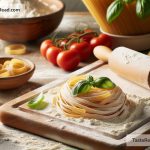How I Mastered the Perfect French Pastry: A Simple Guide
If you’ve ever dreamed of mastering the art of French pastry making but felt intimidated by its complexity, I’m here to share my journey and tips on how you, too, can achieve perfection in your kitchen without needing a professional chef’s skills. French pastries, known for their delicate textures and intricate flavors, might seem out of reach for the average home baker. However, with patience, practice, and a passion for baking, I discovered that creating the perfect French pastry is entirely possible.
Starting with the Basics
My journey began with understanding that good things take time. French pastry-making is no exception. The beauty of these confections lies in their simplicity and the quality of ingredients used. I started by making sure I had the right tools — a good rolling pin, precise measuring tools, and a reliable oven thermometer were my basic but essential arsenal.
The cornerstone of most French pastries is puff pastry, and mastering this was my first challenge. I quickly learned that the key to perfect puff pastry is temperature control — keeping the dough cold ensures that the butter doesn’t melt before baking, which is crucial for achieving those flaky, airy layers French pastries are famous for.
Practice Makes Perfect
Making puff pastry from scratch involved a lot of trial and error. My initial attempts were far from perfect — the dough was either too crumbly or too sticky, and the layers weren’t as pronounced as I hoped. Instead of getting frustrated, I saw each attempt as a learning opportunity. I refined my technique with every batch, paying close attention to the consistency of the dough and the chill times. It wasn’t long before I could feel the subtle differences that would lead to a successful pastry.
Attention to Detail
French pastry making is an art that demands attention to detail. I learned that even the smallest variation in ingredient measurements could dramatically affect the outcome. I began weighing my ingredients instead of measuring them by volume to ensure accuracy. This precision made a noticeable difference in the consistency and texture of my pastries.
Another critical detail was mastering the bake. Achieving the perfect golden-brown exterior without overcooking the interior requires vigilance. I had to learn my oven’s quirks and adjust baking times and temperatures accordingly. Placing an oven thermometer inside was a game-changer, helping me to monitor the actual temperature and make necessary adjustments.
Expanding My Repertoire
With a solid foundation in puff pastry, I felt ready to expand my repertoire. I ventured into making croissants, which shared some techniques with puff pastry but introduced new challenges, such as the yeast-leavened dough. Despite the additional complexity, the principles remained the same — precision, patience, and practice.
I explored other French pastries, each with its unique set of challenges and rewards. From delicate madeleines to rich, creamy éclairs, I experimented and learned. I discovered that the skills and confidence I gained from mastering one type of pastry transferred to others, making each new attempt less daunting.
Sharing the Joy
One of the most rewarding aspects of my journey was sharing the fruits of my labor with friends and family. Their delight and encouragement fueled my passion and drove me to continue perfecting my craft. Baking became not just a personal achievement but a source of joy and connection.
Tips for Aspiring Bakers
Based on my experience, here are a few tips for anyone embarking on their French pastry-making journey:
-
Invest in Quality Ingredients: The simplicity of French pastries means there’s nowhere to hide. Use the best butter, flour, and other ingredients you can find.
-
Embrace Mistakes: Each misstep is a learning opportunity. Don’t be discouraged by failure — it’s a critical part of the process.
-
Be Precise but Flexible: While precision in measuring and techniques is crucial, also learn to trust your instincts and make adjustments as needed.
-
Practice, Practice, Practice: There’s no substitute for repetition. The more you bake, the more intuitive the process will become.
-
Enjoy the Process: Don’t be so focused on the outcome that you forget to enjoy the journey. Savor each step, from mixing the dough to taking that first delicious bite.
Mastering the perfect French pastry didn’t happen overnight. It took persistence, patience, and a lot of butter. However, the sense of achievement that comes from creating something so beautiful and delicious from a few simple ingredients is indescribably satisfying. Whether you’re a seasoned baker or a complete novice, I encourage you to embark on your pastry-making journey. Who knows? The perfect croissant might be closer than you think!


